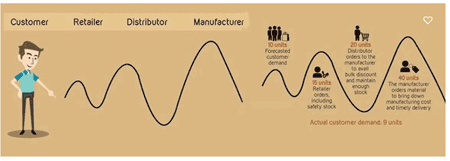The Pandemic Recovery and The Bullwhip Effect
One of - if not the top - most influential concepts in the supply chain is The Bullwhip Effect.
Though I assume known by a high percentage of SCDigest readers, as a quick summary The Bullwhip Effect describes how demand signals get distorted from the point of consumption back up through channel of distribution, manufacturing, components and materials, etc.
| GILMORE SAYS: |
WHAT DO YOU SAY?'
Stank, Goldsby and Saunders say that "just as the initial information reporting demand spikes takes time to reach upstream suppliers and manufacturers, so too does information about stabilizing demand."
Send us your
Feedback here
|
While end consumption, certainly for consumer goods, is often very steady, the upstream order patterns can show much wider variation - big peaks and valleys even though end demand is more constant.
The common results of this phenomenon: excessive inventory, inaccurate product forecasts, insufficient or excessive capacities, poor customer service due to unavailable products or long backlogs, uncertain production planning (i.e., excessive revisions), and high costs for corrections, such as for expedited shipments and overtime.
Dr. Hau Lee of Stanford University and colleagues V. Padmanabhan and Seungjin Whang put The Bullwhip Effect into prime time supply chain thinking with a 1997 article in MIT's Sloan Management Review, which featured insight from both Procter & Gamble and HP on the cause and effect.
The concept is called The Bullwhip Effect because the peak and valley order patterns and/or demand signals look something like the shape of a whip being coiled. (See graphic below).
P&G is credited with coming up with term.
The Bullwhip Effect Leads to Big Variance
in Order Patterns back Up the Supply Chain

See Full Size Image
In addition to capturing a critical supply chain challenge and opportunity, The Bullwhip Effect is the basis for the famous "Beer Game," in which participants play various roles in a beer supply chain.
Communication and collaboration are not allowed between supply chain stages, so players invariably suffer from the Bullwhip Effect-style challenges and wind up with two much or too little inventory.
So, The Bullwhip Effect is a hugely well-known and influential model, and helped propel Dr. Lee to top tier status among supply chain academics.
Except it really isn't The Bullwhip Effect. It's the Forrester Effect.
Noted MIT professor Jay Forrester first developed the insight in the early 1960s, and if fact, was the inventor of The Beer Game.
But somehow the principle took more than a three decade to really take root, catalyzed by Hau Lee's famous article. Maybe only a few companies, let alone whole supply chains, were really ready for the concept when it was created. Maybe The Bullwhip Effect is more memorable than The Forrester Effect.
Why this trip down Bullwhip memory lane? Because earlier this week, Ted Stank, Tom Goldsby, and Lance Saunders, all from the University of Tennessee, published a guest column in the Wall Street Journal saying manufacturers need to be careful about falling victim to The Bullwhip Effect here in this highly volatile post-pandemic environment.
With demand surging in many categories of products in both consumer and business markets, the natural reaction for many companies is to "just make more," the authors note. But they caution that they could fall into a Bullwhip Effect situation.
Stank, Goldsby and Saunders say that "just as the initial information reporting demand spikes takes time to reach upstream suppliers and manufacturers, so too does information about stabilizing demand."
The Bullwhip Effect in part happens due to long lead times to build capacity and significantly increase output. But, the authors say, by the time companies reach peak capacity, demand may have stabilized at lower levels, leaving firms with excessive inventory and assets.
They add that "The risk of overbuilding is highest in industries that may see demand surge as society reopens, such as tourism, dining and entertainment. Data indicate that consumer spending is already shifting away from "lockdown" spending on things such as home entertainment, workout and home-office equipment, and food-delivery services."
Companies, they say, should closely analyze any sharp upticks in demand to avoid amplifying false-demand signals, noting that in the early days of the pandemic, toilet paper demand at retail was up over 700% even though consumer usage was little changed.
The WSJ column takes a longer term view of The Bullwhip Effect relative to adding capacity than The Beer Game and most discussions on The Bullwhip Effect, which are more short term focused on how much inventory to build in the here and now (and how order pattern variability negatively impacts manufacturing and logistics planning).
But the real takeaway here is that all these years later, while The Bullwhip Effect has been modestly tamed in many supply chains - forgetting the principles can still lead to a host of supply chains problems.
What do you think of the Bullwhip discussion? Is it a risk for companies now? Let us know your thought at the Feedback section below.
|












